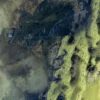I moved to Kharkiv, the embattled second city of Ukraine, in autumn of 2022, one month after the surrounding area’s liberation. I had founded a small charity to help restore war-damaged buildings in the spring of that year, and we planned to begin repair work in the heavily shelled surrounding villages. Kharkiv still felt as though it were sleepwalking, nobody quite believing that the horrors might have partially subsided.
My first flat in the city was in the only undamaged building on what was once a beautiful street in the centre. Sod’s Law ensured that the apartment above mine belonged to an amateur DJ, the only other resident left behind on the street. All through the night he would mix blaring music. I have had noisy neighbours before, of course, and I have lived with amateur DJs whose hobby would keep me up throughout the night. But in time of war, when the city is a black hole of silence in between the sirens, its few residents having cleared off the street long before curfew, electronic music poring through the plaster of the ceiling somehow becomes comforting. Music is such an intentional noise, and the sound of this inescapable proof of life provided some comfort in the context of the enveloping silence around us. The consistency of it – the knowledge that the beats will maintain their rhythm, that the next bar can be predicted, the pattern maintained – compared to the spontaneity of the other sounds that permeate a war zone, felt reassuring.
Driving up the main highway to the villages where we work, you could be forgiven for thinking that there was a warplane flying low overhead. The weight of the hundreds of tanks that moved up and down that highway during the height of the fighting last year damaged the asphalt, meaning that now any contact with a car in motion creates a loud, aggressive hum, recreating the sounds of the battle machinery that was stationed there not long ago.
Once you have turned off that main highway and entered the villages, the first thing you notice is silence. The Kharkiv soundtrack of regular air raid sirens: gone. Electricity here was cut off almost immediately after the war began, and with it went the wailing. The loud generator rumblings that you heard in Kyiv or Lviv over the winter months as Russian bombs pounded Ukrainian infrastructure are also noticeably absent. The few cafes and shops that once existed here have either been destroyed or lie empty, owners and workers having fled. Silence rules in the villages and the people who still live here have gotten used to this new, uneasy peace. The silence is not like the silence you will find in a village untouched by war. It is deeper, filled at first with a taut tension and then eventually with an uneasy calm. In Kyiv or Kharkiv, a sense of panic reverberates with the sirens, no matter how used to them you might become, but these border villages are closer to danger than the cities, and have suffered a far greater damage, and yet, in the absence of sirens, the silence cocoons you.


Sign in to Granta.com.








